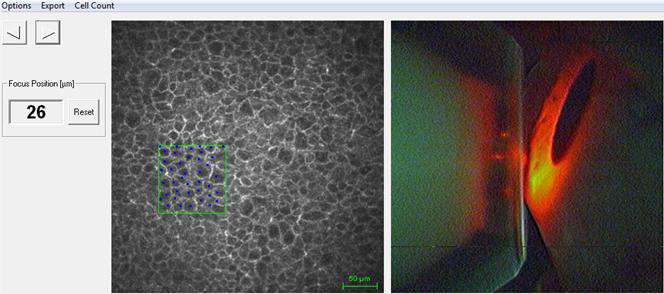Peripheral Epithelial Corneal Hyperfluorescence (PECH) in association with soft contact lens (CL) wear
This bachelor thesis studies the changes of the Corneal Epithel responsible for Hyperfluorescence.
Count of the wing cell density with HEYEX-Software (Heidelberg Engineering).
„Limbal epithelial hypertrophy” is described as a change in the peripheral corneal epithelial layer resulting from hypoxia (induced by prolonged wear of hydrogel contact lenses) and / or from mechanical stress. Due to its characteristic peripheral location on cornea, this phenomenon was named ‘PECH’ (Peripheral Epithelial Corneal Hyperfluorescence) for the purpose of this study.
By means of a retrospective case report study, a treatment group wearing contact lenses (CLs) on a daily basis, showing characteristic symptoms of PECH (PECH yes), was statistically compared to a CL control group showing no signs of PECH (PECH no). These two groups were examined by means of confocal microscopy with the HRT Rostock Cornea Module (Heidelberg Engineering), at the level of the epithelial wing cell layer. Additionally, significant risk factors from a previous investigation (P5) were analysed more specifically concerning the potential key influence for PECH. In addition, an existing selection bias was assessed, by comparing the population of the P5 investigation to the entire contact client base of Optik Nosch in Kirchzarten, Germany.
The wing cell layer density was statistically significantly lower in the peripheral corneal areas with PECH. The obtained results suggest that PECH is likely to be induced by hypoxia.
Project information
- Execution: Yasna Glauser, Stephan Jäggi, BSc Optometry
- Supervision: Daniela S. Nosch

